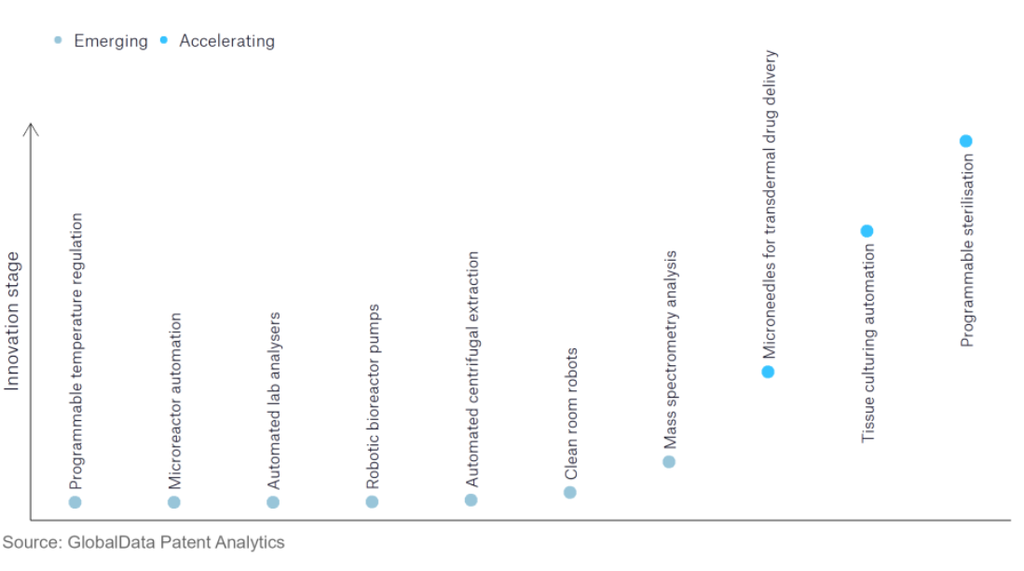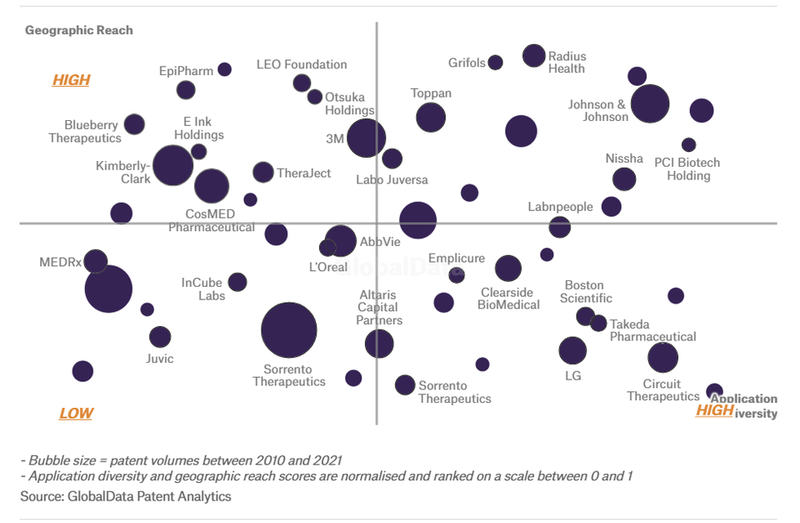The pharmaceutical industry continues to be a hotbed of innovation, with activity driven by the evolution of new treatment paradigms, the gravity of unmet needs, as well as the growing importance of technologies such as pharmacogenomics, digital therapeutics, and artificial intelligence.
In the last three years alone, there have been over 633,000 patents filed and granted in the pharmaceutical industry, according to GlobalData’s report on Robotics in Pharmaceuticals: Microneedles for transdermal drug delivery.
However, not all innovations are equal, nor do they follow a constant upward trend. Instead, their evolution takes the form of an S-shaped curve that reflects their typical lifecycle from early emergence to accelerating adoption before finally stabilising and reaching maturity.
Identifying where a particular innovation is on this journey, especially those that are in the emerging and accelerating stages, is essential for understanding their current level of adoption and the likely future trajectory and impact they will have.
100 innovations will shape the pharmaceutical industry
According to GlobalData’s Technology Foresights, which plots the S-curve for the pharmaceutical industry using innovation intensity models built on over 756,000 patents, there are 110 innovation areas that will shape the future of the industry.
Within the emerging innovation stage, programmable temperature regulation, microreactor automation, and automated lab analysers are disruptive technologies that are in the early stages of application and should be tracked closely.
Microneedles for transdermal drug delivery, tissue culturing automation, and programmable sterilisation are some of the accelerating innovation areas, where adoption has been steadily increasing.
Innovation S-curve for robotics in the pharmaceutical industry

Microneedles for transdermal drug delivery is a key innovation area in robotics
Microneedles are sterilised micron-sized, minimally invasive novel drug delivery needles used to administer therapeutic agents. Apart from transdermal drug delivery applications, its usage has extended to intraocular, cardiovascular, gastrointestinal, intracochlear, lymphatic, and vaginal delivery of drugs.
GlobalData’s analysis also uncovers the companies at the forefront of each innovation area and assesses the potential reach and impact of their patenting activity across different applications and geographies.
According to GlobalData, there are 100+ companies, spanning technology vendors, established pharmaceutical companies, and up-and-coming start-ups, engaged in the development and application of microneedles for transdermal drug delivery.
Key players in microneedles for transdermal drug delivery – a disruptive innovation in the pharmaceutical industry

‘Application diversity’ measures the number of different applications identified for each relevant patent and broadly splits companies into either ‘niche’ or ‘diversified’ innovators.
‘Geographic reach’ refers to the number of different countries each relevant patent is registered in and reflects the breadth of geographic application intended, ranging from ‘global’ to ‘local.’
Patent volumes related to microneedles for transdermal drug delivery
Sorrento Therapeutics is the leading patent filer in microneedles drug delivery, followed by Hisamitsu Pharmaceutical and Kimberly-Clark. Sorrento Therapeutics recently acquired Sofusa, a lymphatic microneedles delivery platform, from Kimberly-Clark.
The company has also recently entered a licensing agreement with the Mayo Clinic for a Phase 1b pilot study on using Sofusa lymphatic microneedle to deliver Ipilimumab in patients with melanoma.
In terms of application diversity, Broadcom is the top company, followed by Endoderma and PCI Biotech. By means of geographic reach, Radius Health holds the top position. Grifols and Ichor Medical Systems are in the second and third positions, respectively.
To further understand the key themes and technologies disrupting the pharmaceutical industry, access GlobalData’s latest thematic research report on Pharmaceutical.
GlobalData, the leading provider of industry intelligence, provided the underlying data, research, and analysis used to produce this article.
GlobalData’s Patent Analytics tracks patent filings and grants from official offices around the world. Textual analysis and official patent classifications are used to group patents into key thematic areas and link them to specific companies across the world’s largest industries.